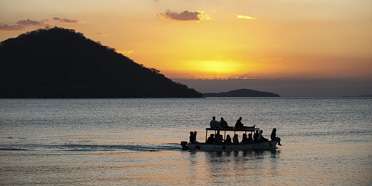
Lizzie is a reputed guidebook writer and author of the Footprint guides to South Africa, Namibia, Kenya, Tanzania, Uganda and Zimbabwe.
7 people found this review helpful.
A Charming Slither of a Country With Africa’s Third Largest Lake and Fast-Developing Safari Parks
Split by the Great Rift Valley and enormous Lake Malawi, and bordered by Zambia, Tanzania and Mozambique, Malawi has a lot going for it thanks to the legendary friendliness of the people and a distinctly chilled vibe. I’ve explored extensively here from relaxing at a resort on a sandy beach next to the impossibly clear fresh waters – so lovely to swim, snorkel and kayak in – to hiking in the pretty forests on the lofty Zomba Plateau. It’s hard to know where to start listing the highlights but the lake itself is the drawcard for all visitors. As it covers almost 30% of the country, there are numerous choices from budget thatched resorts to more upmarket beach hotels, but at all, feet-in-the-sand with a cold Malawian beer is the norm. The lakeshore towns and villages are relaxed and offer rustic cafés, vibrant markets and unpressured souvenir shopping – my favourites are Nkhata Bay and Cape Maclear – and inland, towns like Salima and Mzuzu, and even the capital Lilongwe, have unhurried laidback atmospheres.
Malawi is home to nine national parks and wildlife reserves. Lake Malawi National Park at Cape Maclear covers part of the shoreline, numerous rocky islands and the lake itself. Wildlife present includes baboons, small antelope and rock hyrax, while fish eagles, cormorants and hamerkops soar overhead. But to see the main attraction of Lake Malawi National Park you must get wet, and with a mask and snorkel you can observe glittering shoals of endemic and beautifully multi-coloured cichlids. Even when I’ve been kayaking here, looking down into the crystal-clear water is like peering into an aquarium.
While the terrestrial parks haven’t historically compared to neighbouring Tanzania and Zambia as safari destinations, things are changing rapidly and there has been much development in recent years. The flagship park is 580-sq-km Liwonde; with the Shire River on its border, it features ancient baobab trees and borassus palms, floodplains, dense woodlands and lagoons. These sustain zebra, antelope, buffalo, hyena, crocodile and hippo, and Malawi’s largest populations of elephant and black rhino. African Parks assumed management in 2015 and have since greatly impacted on the park’s conservation. They have fenced it (reducing human-wildlife conflict), reintroduced cheetah and lion, and translocated more than 500 elephants along with other game animals to Nkhotakota Wildlife Reserve and Majete Wildlife Reserve to reduce habitat degradation in Liwonde and restock these other burgeoning safari destinations. Additionally, new accommodation of international standards has opened up in all of these. I for one am excited about my next visit to Malawi, and I’ll brush the sand off my feet and enjoy visiting these newly rejuvenated parks and reserves which are firmly putting Malawi on the safari map.

Ariadne is a renowned African wildlife photographer whose work is featured in many well-known guidebooks and magazines.
1 person found this review helpful.
An Emerging Safari Destination
When I first visited Malawi in the 1990s, it was essentially a backpacker destination. There were very few facilities for upmarket tourists. However, the combination of Lake Malawi’s beautiful sandy beaches, cheap living and chilled atmosphere made it easy for long-term travelers to hang out indefinitely in this small country, affectionately nicknamed the ‘Warm Heart of Africa’.
Although Malawi is still slightly off-the-beaten track and refreshingly low-key, its tourist industry has come a long way since then, and the country is now a recognized safari destination.
This transition is largely thanks to the involvement of African Parks – a highly successful conservation non-profit organization – in the management of some of Malawi’s main parks, namely Liwonde National Park, Majete Wildlife Reserve and Nkhotakota Wildlife Reserve.
Liwonde is my favorite park in Malawi. The Shire River, the park’s lifeline, is one of Africa’s magic waterways. Hippos and crocs are abundant, and the palm-dotted floodplain attracts a steady stream of thirsty animals. Boat trips are highly recommended, especially in the late afternoon, which is the best time to see elephants drink and play in the water. And in recent years, African Parks has helped curtail poaching by erecting fences and removing snares, whilst restoring the natural balance of the ecosystem with the successful reintroduction of lion and cheetah.
Where Liwonde needed a helping hand to return to its former glory, Majete needed rebuilding from scratch. In 2003, when African Parks took over Majete, the reserve was depleted of wildlife as a result of decades of neglect and poaching. Since then, more than 3,000 individual animals have been reintroduced to Majete, including several black rhino, and the reserve is now a proper Big Five safari destination.
More recently, African Parks acquired Nkhotakota Wildlife Reserve. Although this vast wilderness still needs further development to become a viable tourist destination, the historic relocation of 520 elephants and another 1,400 other animals has been the first step towards putting it back on the map.
There are several other reserves worth visiting, not least Nyika National Park, with its green rolling hills, reminiscent of the European countryside. Its high-altitude plateau is a wonderful place for walking, and perhaps the best place in the country to see the elusive leopard.

Harriet is a zoologist with more than 20 years’ experience. She has the privilege of working with the world’s top wildlife photographers and photo-guides.
1 person found this review helpful.
More Than Just a Lake
Malawi is one of Africa’s poorest and most densely populated countries but, though it might sound like a cliché, it really does have some of the friendliest people. The country is dominated by the eponymous lake, and there are lots of associated lake-based activities – with beach resorts, snorkelling, kayaking and island-hopping trips.
But there is much more to Malawi than just the lake. In the south are great hiking options on the peaks of Mt Mulanje and the Zomba Plateau. There is also good hiking on the Nyika Plateau in the western highlands, with its rolling grasslands, eland and roan antelope, and more than 200 orchid species.
Malawi is a rewarding and varied birding destination, with localised specials including the green-headed oriole, brown-breasted barbet and white-winged apalis. Until recently Malawi was dismissed as a safari destination. However, this has changed in recent years with the inspirational NGO African Parks having assumed management of three key parks and reserves.
African Parks took over the management of Majete Wildlife Reserve in 2003, and since then it has reintroduced all the Big Five. More recently, it has eliminated poaching and illegal fishing in the beautiful Liwonde National Park. On one afternoon’s boat trip at Liwonde I saw elephants, hippos, Pel’s fishing owl and African skimmers. Most recently African Parks have translocated 500 elephants from Liwonde to Nkhotakota Wildlife Reserve – Malawi’s oldest conservation area, and one of its largest. The future is looking bright for Malawi’s parks and reserves.

Dale is a multi-award-winning writer and photographer with more than 500 published magazine articles featured in magazines such as National Geographic, BBC Wildlife, Travel Africa, and CNN Travel.
Chill in the African Heat
One of my favourite memories of anywhere in Africa was of a quiet sunset evening, perched atop a granite boulder near Cape Maclear overlooking the beautiful Lake Malawi.
As the sun dipped below the horizon, casting hues of pink and mauve across the sky, I found myself in solitude, accompanied only by a group of vervet monkeys settling down in the trees behind me. Sipping on my gin and tonic (supplied by the lodge – bless them), I watched as the star-studded canvas of the night sky transformed the water into a shimmering mirror.
I imagine David Livingstone saw what I was seeing and perhaps felt what I was feeling when he described this place as a ‘Lake of Stars’ upon his sojourn here in 1859.
Then, from the silence, came the sound of men singing traditional African songs. I wondered at first where this baritone choir might be, but then I saw them, rowing into the cosmos in a dozen or more dugout canoes. They carried lanterns to light their way (and to attract fish, no doubt), and as they moved further from the shore, their synchronous voices faded along with the last vestiges of the day’s light, and their lamps became one with the stars.
I have never sighed so deeply nor felt more at peace.
I’m not saying that everyone who visits the lake will get to experience such a thing. Perhaps I was just lucky, but there’s no doubt that Malawi is a chilled and tranquil place.
The people are generally friendly and welcoming, and the whole place (except for the towns and cities) has a distinctly laid-back feel to it.
Visitors can enjoy boat cruises, snorkelling and scuba diving in Lake Malawi’s crystal-clear waters. The colourful endemic fish more resemble those found on a coral reef than in a freshwater environment.
And as for the safari vibe, parks and reserves include Liwonde, Majete, Nyika, Vwaza Marsh and Kasungu, all of which are well worth a visit.

Sue is an award-winning writer who specializes in African travel and conservation. She writes for national newspapers, magazines, Rough Guides and Lonely Planet.
More Than ‘The Warm Heart of Africa’
Malawi is well known as the ‘warm heart of Africa’ because of its welcoming, friendly people. While that moniker is certainly true, there’s much more to this tiny country than meets the eye, and its people are just one reason to visit.
Lake Malawi, the third largest lake in Africa, dominates the country and until recently was the main attraction for tourists. One of my fondest memories of our nine-month trip across Africa was spending five days on the MV Ilala ferry, which journeys the length of the lake. It’s by no means luxurious, but if you want a true glimpse of local life and soul then jump on board and enjoy. Around the lake, Cape Maclear and Nkhata Bay are great places to stay and have superb snorkeling to see cichlids – with 875 different species, there are more species of this fish here than in any other lake in the world.
But beyond the lake, Malawi is now getting a name for itself as a wildlife destination, thanks to the hard work of conservation organisation African Parks, which now manages three of the country’s protected areas. African Parks was first successful with Majete Wildlife Reserve, which within 10 years was transformed from a poachers’ paradise to a thriving Big Five destination. It followed suit with Liwonde National Park and is now restoring and restocking Nkhotakota Wildlife Reserve. All three are beautiful reserves in their own rights, but together they tell an inspiring conservation success story.
Malawi is also home to Central Africa’s highest mountain. Mulanje is a huge, isolated granite massif that rises steeply from plains of tea plantations, with 20 peaks of over 2,500m jutting into the sky. Sapitwa, the highest peak, translates as ‘Don’t go there’ and it shouldn’t be underestimated. You don’t need technical skills, but be prepared for robust scrambling and negotiating challenging boulders – the reward of fabulous vistas of Zomba Mountain to the north and Mozambique to the south makes it all worthwhile.

Philip is an acclaimed travel writer and author of many guidebooks, including the Bradt guides to Uganda, Tanzania, Kenya and South Africa.
Land of the Lake … and Some Great Safari Options Too!
Malawi is widely – and justifiably – regarded as one of the friendliest and most likeable countries in Africa. Its scenic centrepiece is Lake Malawi, a gaspingly beautiful 585km-long freshwater body lined with palm-fringed sandy beaches and hemmed in by the sheer walls of the Rift Valley. For many years, tourism to Malawi amounted almost exclusively to a steady trickle of backpackers chilling out on the lakeshore en route between eastern and southern Africa. Malawi today still attracts plenty of backpackers, but it is also emerging as a worthwhile off-the-beaten-track safari destination, offering the opportunity to explore a trio of well-managed and contrasting reserves.
The most southerly of these parks, managed privately by an NGO called African Parks since 2003, is Majete Wildlife Reserve, which extends westward from the Shire River south of Blantyre. Following an ambitious program of translocations, Majete is now a fully fledged Big Five destination that supports around 400 elephant, 2,000 buffalo and almost 100 lion, as well as growing populations of leopard, black rhino, cheetah, African wild dog, giraffe, zebra and several antelope species.
Further north, Liwonde National Park is notable for its evocative location on the Shire River, dense numbers of elephant and hippo, and peerless birdlife. Also now managed by African parks, Liwonde has been subject to several important translocations in recent years, and visitors are very likely to see lion, and might also get lucky with the likes of cheetah, black rhino and African wild dog. Finally, the lofty Nyika National Park, in the far north of the country, supports a majestic highland plateau whose grasslands and forests support a wealth of large mammals and birds.
Overall, Malawi is too small and its circuit too fragmented to compete with the likes of Tanzania or Botswana as a top-drawer safari destination, but it will appeal greatly to those who want to get off the beaten track, and to supplement a diet of conventional game drives with boat trips (in Liwonde) and guided walks (in both Liwonde and Nyika). It is also a great country to round off a safari with a few days hanging out on one of the freshwater lake’s beautiful and very relaxed beaches.

James is a travel writer and author of many Lonely Planet guides, including senior author of the guide to South Africa, Lesotho and Swaziland.
Emerging Safari Destination
Often overshadowed by its wildlife-packed neighbouring countries, tiny Malawi is one of Africa’s most exciting up-and-coming safari destinations, largely thanks to the conservation work of NGO African Parks in Liwonde National Park and Majete and Nkhotakota Wildlife Reserves. Adding to the appeal of Lake Malawi’s laidback beach towns, iridescent cichlids and desert islands, Majete and Liwonde now offer the Big Five, while the stunning Nyika National Park is known for its leopard. Liwonde is also one of Africa’s best spots for river-based wildlife watching.
Conservation success stories have included lion, cheetah and black rhino translocations from South Africa to both Majete and Liwonde. In 2016 and 2017, African Parks broke conservation records with the translocation of no fewer than 520 elephants and 1,400 game animals from overpopulated Majete and Liwonde to Nkhotakota Wildlife Reserve. Britain’s Prince Harry took part in the historic translocation; the rugged royal, who served as President of African Parks from 2017 to 2023, spent three weeks carrying out tasks such as anaesthetising and affixing radio collars.
Malawi is really buzzing with this celebrity involvement, and with luxurious new wildlife lodges adding to the existing choice, it has duly featured in several recent ‘top places to visit’ lists compiled by everyone from Rough Guides to Vogue. It’s great news for one of the world’s poorest countries, where tourism contributes over 7% of GDP. With all that said, Malawi remains an emerging safari destination, where exploring the African bush in uncrowded parks, staffed by enthusiastic and welcoming locals, is as much a part of the experience as animal sightings. The bird watching is excellent in the likes of Nyika and Liwonde, while the latter’s lodges offer the novelty of boat safaris.

Stephen is a travel writer and avid conservationist whose work appears in prestigious magazines such as Africa Geographic and Travel Africa.
Dynamite Comes in Small Packages
Known as the warm heart of Africa, Malawi is an enchanting and welcoming country that is undoubtedly home to the friendliest people in all of Africa. While it might lack the abundant wildlife resources and expansive protected areas of some its more illustrious safari neighbours, Malawi makes up for this with its friendliness, ease of travel, diversity of enchanting tourist experiences, host of attractive little reserves and rapidly rebounding wildlife.
Lake Malawi (with its enticing Mumbo, Domwe and Likoma islands) leads the way in visitor popularity, but the rejuvenated protected areas of Liwonde National Park, Majete Wildlife Reserve, Nkhotakota Wildlife Reserve and Nyika National Park are certainly worth exploring. Twitchers will be mesmerised by a species list that tops 650 birds in a fairly small country, while hikers will likely head to Mount Mulanje, Zomba Plateau or Nyika (with the multi-day Livingstonia hiking trail) for their ambulatory adventures.
Since African Parks – the renowned conservation non-profit – first ventured into Malawi and took over the rehabilitation and long-term management of the derelict Majete Wildlife Reserve in 2003, the organisation has expanded its Malawi portfolio to include Nkhotakota Wildlife Reserve and Liwonde National Park. The cutting-edge protected-area management practices implemented by African Parks – combined with a whole host of wildlife reintroductions – has seen top-quality safari operators like Robin Pope Safaris and Central African Wilderness Safaris expand their lodge offerings in Malawi.
The protected area transformation and wildlife restorations that African Parks catalysed in Malawi catapulted the country from a safari backwater into one of the most popular emerging African safari destinations. Today Malawi is one of the continent’s most complete travel destinations, with wildlife, water sports, diving, hiking, biking, community engagement and lakeside relaxation all on offer. Consequently, the country has been scooping travel awards in recent years, as this exciting and fun-loving destination bursts back onto the international safari scene. This is a country and destination that is very much on the up right now.







